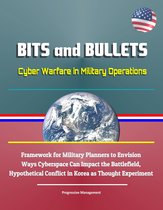Applying Lessons Learned from Interwar Airpower (1919-1939) to Joint Warfighting With Cyberpower - Change Agents Moffett, Patrick, Reeves; Army and Navy Doctrine, Personnel, and Technology Ebook Tooltip Ebooks kunnen worden gelezen op uw computer en op daarvoor geschikte e-readers.
Afbeeldingen
Sla de afbeeldingen overArtikel vergelijken
- Engels
- E-book
- 9780463808658
- 05 maart 2019
- Epub zonder kopieerbeveiliging (DRM)
Samenvatting
This important report has been professionally converted for accurate flowing-text e-book format reproduction. The United States has yet to use cyberwarfare in a major conflict, and the military services have differing ideas on what role cyberwarfare will play in America's next war. In addition, the services have unique and often contradictory perspectives on how they see the employment of cyberwarfare in military operations, and this conflict may affect combatant commanders' ability to employ cyberpower in their areas of responsibility. The United States military faced a similar problem after World War I when attempting to understand and exploit the nascent capabilities of airpower, which showed great potential but exited the Great War with an inconclusive service record. The Interwar Period saw rapid advancement in aviation, and the U.S. military struggled with questions of how best to organize, equip, and employ airpower after World War I's inconclusive results. The differing approaches of the United States Army and the United States Navy toward airpower evolution during the Interwar Period yield several lessons in the areas of doctrinal, personnel, and technological development that are applicable to the future employment of Joint cyberpower in the post-Afghanistan War era.
This paper first explores how the culture and biases of the Army, Army Air Corps and Navy influenced the development of Interwar airpower theory and doctrine. It then examines airpower development through the lens of personnel, and uses the concepts of the change agent and the heterogeneous engineer to show how airpower development depended on the expertise and political acumen of senior officers who believed in airpower's potential and were determined to make it a reality. Finally, it looks at how the Army Air Corps and the Navy managed uncertainty about the nature of the nation's next war while in an environment marked by rapid technological progress in aviation.
This compilation includes a reproduction of the 2019 Worldwide Threat Assessment of the U.S. Intelligence Community.
Productspecificaties
Inhoud
- Taal
- en
- Bindwijze
- E-book
- Oorspronkelijke releasedatum
- 05 maart 2019
- Ebook Formaat
- Epub zonder kopieerbeveiliging (DRM)
Betrokkenen
- Hoofdauteur
- Progressive Management
- Hoofduitgeverij
- Smashwords Edition
Lees mogelijkheden
- Lees dit ebook op
- Android (smartphone en tablet) | Kobo e-reader | Desktop (Mac en Windows) | iOS (smartphone en tablet) | Windows (smartphone en tablet)
Overige kenmerken
- Studieboek
- Nee
EAN
- EAN
- 9780463808658
Je vindt dit artikel in
- Categorieën
- Taal
- Engels
- Boek, ebook of luisterboek?
- Ebook
- Beschikbaarheid
- Leverbaar
- Beschikbaar in Kobo Plus
- Beschikbaar in Kobo Plus
Kies gewenste uitvoering
Prijsinformatie en bestellen
De prijs van dit product is 5 euro en 52 cent.- E-book is direct beschikbaar na aankoop
- E-books lezen is voordelig
- Dag en nacht klantenservice
- Veilig betalen
Rapporteer dit artikel
Je wilt melding doen van illegale inhoud over dit artikel:
- Ik wil melding doen als klant
- Ik wil melding doen als autoriteit of trusted flagger
- Ik wil melding doen als partner
- Ik wil melding doen als merkhouder
Geen klant, autoriteit, trusted flagger, merkhouder of partner? Gebruik dan onderstaande link om melding te doen.








